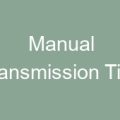Car Diy Maintenance

Car DIY maintenance is essential for vehicle owners. Regularly check and change fluids, inspect brakes, replace filters, and maintain tires for optimal performance and longevity.
Taking care of your car through DIY maintenance is crucial for its longevity and performance. Regularly changing oil and filters is essential to keep your engine running smoothly. Additionally, checking and topping up fluids such as coolant and brake fluid is important for optimal functionality. Inspecting and replacing spark plugs and ignition coils can improve fuel efficiency and prevent engine misfires. Furthermore, rotating tires and maintaining proper tire pressure ensures even wear and enhances safety. Lastly, cleaning and waxing your car’s exterior and vacuuming the interior not only enhances its appearance but also helps protect the paint and upholstery. Adopting a regular car DIY maintenance routine will save you money and keep your vehicle in top shape.
| Regularly check and change engine oil for optimal car performance. |
| Maintain proper tire pressure to improve fuel efficiency and tire lifespan. |
| Inspect and replace brake pads to ensure safe driving and stopping. |
| Keep the battery terminals clean to avoid electrical issues and starting problems. |
| Clean or replace air filters to enhance engine performance and fuel economy. |
- Regularly check and top up coolant levels to prevent engine overheating.
- Inspect and maintain spark plugs for efficient combustion and smooth running.
- Check and replace wiper blades for clear visibility during rainy conditions.
- Regularly inspect and adjust drive belts to prevent engine damage.
- Keep headlights clean and properly aligned for optimal visibility at night.
What are the most common car DIY maintenance tasks?
Car DIY maintenance tasks include changing the oil, replacing the air filter, checking tire pressure, and changing spark plugs.
Additionally, rotating tires, replacing brake pads, and changing the cabin air filter are also common tasks.
Regularly cleaning the battery terminals and checking fluid levels such as coolant, brake fluid, and windshield washer fluid is important too.
How often should I change my car’s oil?
The frequency of oil changes depends on several factors, including the type of oil used and the driving conditions.
Generally, it is recommended to change the oil every 3,000 to 5,000 miles or every 3 to 6 months.
However, newer vehicles and synthetic oils may allow for longer intervals, up to 7,500 to 10,000 miles.
What are the signs that my car needs a new battery?
Signs of a failing car battery include difficulty starting the engine, dim headlights, and electrical issues.
If your car takes longer to start or if you hear clicking sounds, it may be time for a replacement.
Additionally, a check engine or battery warning light illuminated on the dashboard should not be ignored.
How do I check and top up my car’s coolant?
To check the coolant level, allow the engine to cool down and locate the coolant reservoir.
Remove the cap and visually check if the coolant is between the minimum and maximum marks.
If necessary, add a mixture of coolant and water, ensuring the correct ratio specified by the manufacturer.
What should I do if my car’s check engine light comes on?
If the check engine light illuminates, it indicates a potential issue with your vehicle.
First, check the gas cap to ensure it is properly tightened.
If the light persists, it is recommended to schedule a diagnostic with a qualified mechanic to identify the underlying problem.
How can I maintain my car’s tires for optimal performance?
Regularly check tire pressure using a pressure gauge and ensure it matches the manufacturer’s recommended levels.
Rotate the tires every 5,000 to 8,000 miles to promote even wear and extend their lifespan.
Inspect the tread depth regularly and replace the tires when the wear indicators become visible.
What are the steps to replace a car’s air filter?
Locate the air filter housing under the hood of your car.
Open the housing and carefully remove the old air filter.
Insert a new air filter with the correct orientation and close the housing securely.
How often should I replace my car’s brake pads?
The frequency of brake pad replacement depends on driving habits and vehicle usage.
As a general guideline, brake pads are typically replaced every 25,000 to 70,000 miles.
However, it is important to have them inspected regularly to ensure optimal braking performance.
What are the signs of a worn-out serpentine belt?
Symptoms of a worn-out serpentine belt include squealing or chirping noises from the engine area.
You may also experience power steering or air conditioning issues or see the battery light illuminated.
If any of these signs occur, it is advisable to replace the serpentine belt promptly to prevent further damage.
How can I change a car’s headlight bulb?
Access the headlight bulb by opening the hood or accessing it from the front wheel well.
Disconnect the electrical connector and remove the retaining clip or screw holding the bulb in place.
Insert the new bulb and ensure it is securely in place before reconnecting the electrical connector.
What are the steps to change a car’s wiper blades?
Lift the wiper arm away from the windshield and press the release tab on the wiper blade.
Slide the old blade out of the wiper arm and attach the new blade in its place.
Make sure it is securely attached before lowering the wiper arm back onto the windshield.
How do I change a car’s cabin air filter?
Locate the cabin air filter compartment, usually behind the glove box or under the dashboard.
Remove the cover and take out the old cabin air filter.
Insert the new filter in the correct orientation and secure the cover back in place.
What are the steps to change a car’s spark plugs?
Locate the spark plugs, usually connected to thick ignition wires or coils.
Disconnect the wires or coils and use a spark plug socket and ratchet to remove the old plugs.
Gap the new spark plugs as specified by the manufacturer and install them using the socket and ratchet.
How can I check my car’s battery health?
Using a multimeter, set it to the DC voltage setting and connect the probes to the battery terminals.
A fully charged battery should read around 12.6 volts. If the reading is significantly lower, it may indicate a weak battery.
Additionally, a battery load test can be performed at an auto parts store to determine its overall health.
How do I clean my car’s battery terminals?
Mix a solution of baking soda and water and apply it to the battery terminals.
Use a battery terminal brush to gently scrub the terminals and remove any corrosion.
Rinse with clean water and dry the terminals before reconnecting the battery cables.
What are the steps to bleed a car’s brake system?
Start by locating the brake bleeder valve on each wheel.
Attach a clear plastic hose to the valve and submerge the other end in a bottle of brake fluid.
Have a helper press the brake pedal while you open the valve to release any air bubbles. Repeat for each wheel.
How often should I replace my car’s fuel filter?
The frequency of fuel filter replacement depends on the vehicle and the type of fuel used.
As a general guideline, it is recommended to replace the fuel filter every 20,000 to 40,000 miles.
However, it is best to consult the vehicle’s owner manual or a trusted mechanic for specific recommendations.





















